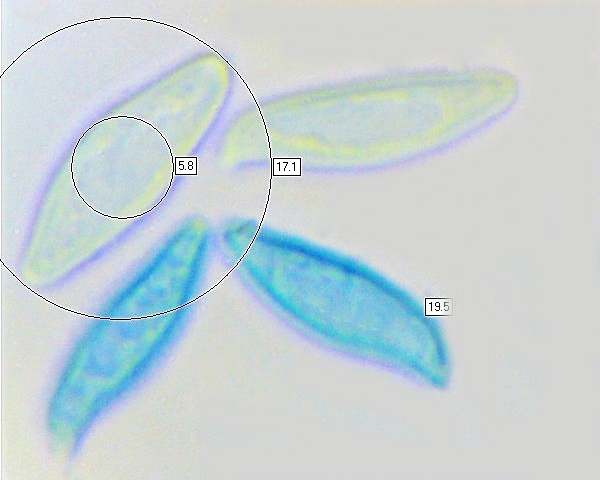Lepiota magnispora Murrill - Yellowfoot Dapperling
Phylum: Basidiomycota - Class: Agaricomycetes - Order: Agaricales - Family: Agaricaceae
Distribution - Taxonomic History - Etymology - Identification - Toxicity - Reference Sources
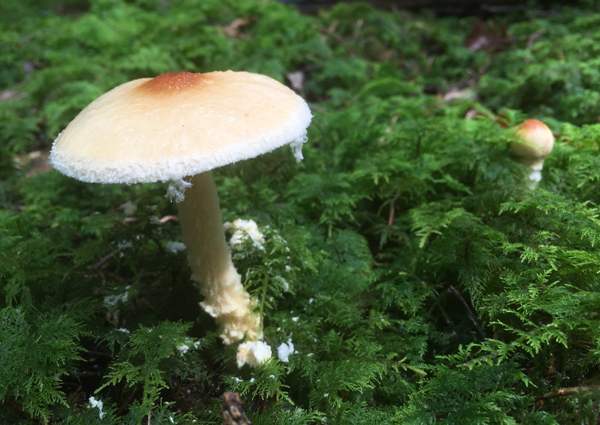
Dapper to some, but to others rather scruffy, the Yellowleg dapperling Lepiota magnispora is perhaps best recognised in the field by the ragged veil fragments that hang from the rim of its scaly cap. Several other Lepiota species have brownish scaly caps, darker towards the centre, but as the scientific name implies this one has huge spores, and more significantly they are shaped like spindles (fusoid) rather than being ellipsoidal or amygdaloid (almond-shaped) as are the spores of many other red-brown-capped Lepiota species.
Distribution
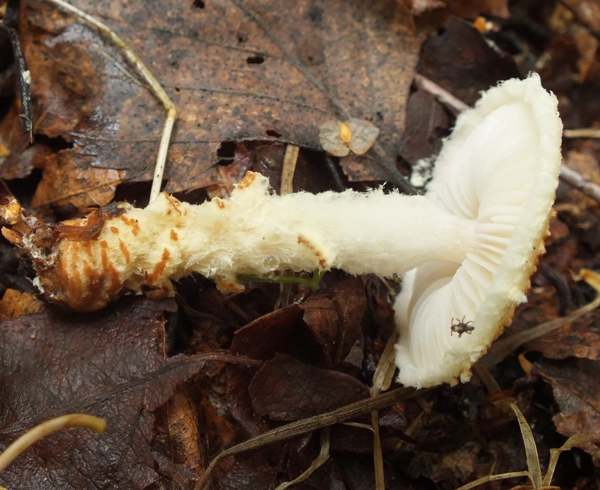
Widespread but rather an uncommon find in woodlands across Britain and Ireland, mainly in broadleaf and mixed woodlands but just occasionally in conifer forests too, Lepiota magnispora occurs also in many parts of mainland Europe, from Iceland and northern Scandinavia right down to the Mediterranean region.
This pretty dapperling is widely distributed across North America, where it is found in both broadleaf and coniferous forest.
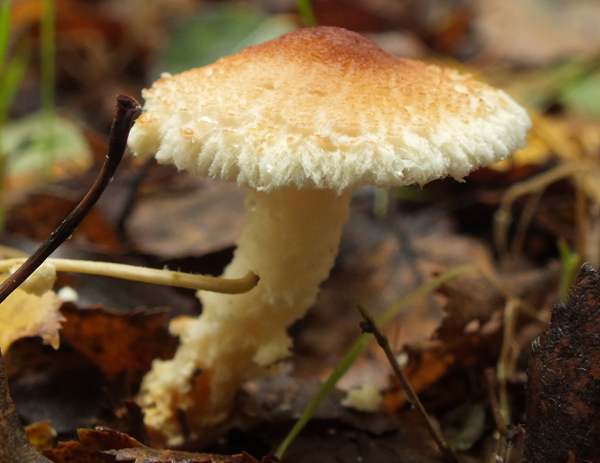
Taxonomic history
This mushroom was described in 1912 by American mycologist William Alphonso Murrill (1869 - 1957), who gave it the binomial scientific name Lepiota magnispora.
Synonyms of Lepiota magnispora include Lepiota ventriosospora D.A. Reid, and Lepiota ventriosospora var. fulva Bon.
Although more brightly coloured and having larger fusoid spores (very reminiscent of bolete spores), the Yellowfoot Dapperling was nevertheless treated by Carlton Rea as synonymous with Lepiota clypeolaria and by Berkeley & Broome as Agaricus metulisporus (= Lepiota metulispora).
Etymology
Lepiota, the genus name, comes from Greek words Lepis, meaning scale, and ot, meaning ear. Scaly ear fungus is an interpretation, therefore. Scales on a convex (vaguely ear-shaped) cap are characteristic of fungi in this genus, as also are free gills and a stem ring.
The specific epithet magnispora means with large spores.
Identification guide
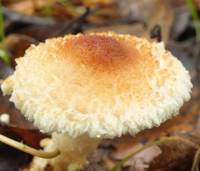 |
CapInitially hemispherical, becoming convex and sometimes almost flat with a slight umbo; white with a reddish-brown smooth centre surrounded by concentric rings of reddish-brown scales, more yellow-orange towards the rim. Pointed whitish veil tatters usually hang down from the rim of the cap. Cap diameter at maturity ranges from 4 to 7cm. |
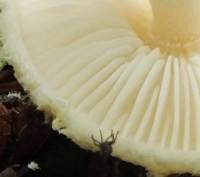 |
GillsThe rather distant thick gills are white or cream; they terminate free of the stem. StemCreamy white; 3 to 5cm long and 4 to 8mm diameter; usually curved, tapering slightly towards the apex; finely woolly above a superior ring (often poorly delineated); with large woolly scales below the ring zone, increasingly yellowish or yellow-orange towards the base. |
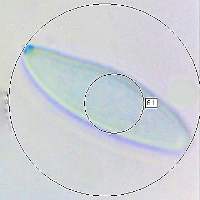 |
SporesEllipsoidal to ovoid, smooth, 15-20 x 4.5-5.5μm; dextrinoid.
Spore printWhite. |
Odour/taste |
Not significant. |
Habitat & Ecological role |
Saprobic, solitary or in small groups mainly in broadleaf woodland (esp. with beeches and oaks) but occasionally in coniferous forests and plantations. |
Season |
August to October in Britain and Ireland. |
Similar species |
Lepiota ignivolvata has a bright orange or red-brown ring low down on the stem. Lepiota cristata is typically larger with paler scales and has an unpleasant odour. |
Toxicity
Lepiota magnispora is generally regarded as inedible. In my opinion there are no dapperlings worth collecting to eat, particularly because confident identification in the field is very difficult and several of them are seriously toxic toadstools. For example, Lepiota cristata the Stinking Dapperling is poisonous and could be mistaken for a small edible Parasol Mushroom Macrolepiota procera. If what you believe to be Parasols are smaller than 10cm in cap diameter then check very carefully, because it is possible that they are actually poisonous Lepiota species.
Reference Sources
Fascinated by Fungi, 2nd Edition, Pat O'Reilly 2016, reprinted by Coch-y-bonddu Books in 2022.
Funga Nordica: 2nd edition 2012. Edited by Knudsen, H. & Vesterholt, J. ISBN 9788798396130
British Mycological Society. English Names for Fungi
Dictionary of the Fungi; Paul M. Kirk, Paul F. Cannon, David W. Minter and J. A. Stalpers; CABI, 2008
Taxonomic history and synonym information on these pages is drawn from many sources but in particular from the British Mycological Society's GB Checklist of Fungi.
Acknowledgements
This page includes pictures kindly contributed by Simon Harding.
Fascinated by Fungi. Back by popular demand, Pat O'Reilly's best-selling 450-page hardback book is available now. The latest second edition was republished with a sparkling new cover design in September 2022 by Coch-y-Bonddu Books. Full details and copies are available from the publisher's online bookshop...

